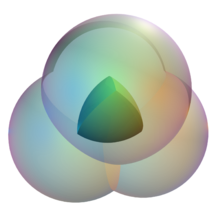
Back Reuleaux-tetraëder Afrikaans Reuleaux-Tetraeder German Tetraedro de Reuleaux Spanish Tétraèdre de Reuleaux French Tetraedro di Reuleaux Italian ルーローの四面体 Japanese Тетраэдр Рёло Russian Тетраедр Рело Ukrainian



The Reuleaux tetrahedron is the intersection of four balls of radius s centered at the vertices of a regular tetrahedron with side length s.[1] The spherical surface of the ball centered on each vertex passes through the other three vertices, which also form vertices of the Reuleaux tetrahedron. Thus the center of each ball is on the surfaces of the other three balls. The Reuleaux tetrahedron has the same face structure as a regular tetrahedron, but with curved faces: four vertices, and four curved faces, connected by six circular-arc edges.
This shape is defined and named by analogy to the Reuleaux triangle, a two-dimensional curve of constant width; both shapes are named after Franz Reuleaux, a 19th-century German engineer who did pioneering work on ways that machines translate one type of motion into another. One can find repeated claims in the mathematical literature that the Reuleaux tetrahedron is analogously a surface of constant width, but it is not true: the two midpoints of opposite edge arcs are separated by a larger distance,
© MMXXIII Rich X Search. We shall prevail. All rights reserved. Rich X Search
